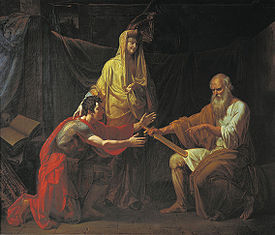
Marfa Boretskaya
Encyclopedia


Posadnik
Posadnik was the mayor in some East Slavic cities or towns. Most notably, the posadnik was the mayor of Novgorod and Pskov...
in 1438-1439 and again in 1453. According to legend and historical tradition, she led the republic's struggle against Muscovy between her husband's death and the city's eventual annexation by Ivan III of Russia
Ivan III of Russia
Ivan III Vasilyevich , also known as Ivan the Great, was a Grand Prince of Moscow and "Grand Prince of all Rus"...
in 1478.
Biography
While she is referred to as Mayoress, this was in no way a formal office. Russians traditionally refer to the wife of certain officials by the feminine equivalent, hence the priest's (pop) wife may be referred to a "priestess" or a general's wife may be referred to a "general-ess" without it meaning that she herself exercised any actual power. In the case of Marfa, she may have been the focal point of the anti-Muscovite faction and had considerable charisma or influence as the matriarch of the clan, but never held actual office in Novgorod as they were confined to the male land-owners.Little is known of Marfa's personal life. She was widowed at some time in the 1460s and remained one of the wealthiest Novgorodian landowners (based on the Pistsovye Knigi or land cadasters compiled by Muscovite officials beginning in the 1490s) until Ivan III's confiscations of land in the 1470s and 80s. It was probably to defend her wealth that she opposed the Muscovite grand princes who had sought to take over Novgorodian estates going back into the late 14th century.
In 1471 Marfa and her sons, Dmitrii and Fedor, as the last representatives of the anti-Muscovite Boretsky family, attempted to negotiate with Casimir IV Jagiellon
Casimir IV Jagiellon
Casimir IV KG of the House of Jagiellon was Grand Duke of Lithuania from 1440, and King of Poland from 1447, until his death.Casimir was the second son of King Władysław II Jagiełło , and the younger brother of Władysław III of Varna....
the terms of the city's handover to the Grand Duchy of Lithuania
Grand Duchy of Lithuania
The Grand Duchy of Lithuania was a European state from the 12th /13th century until 1569 and then as a constituent part of Polish-Lithuanian Commonwealth until 1791 when Constitution of May 3, 1791 abolished it in favor of unitary state. It was founded by the Lithuanians, one of the polytheistic...
, provided that the city's ancient privileges and rights will be retained. They also invited Mikhailo Olelkovich
Mikhailo Olelkovich
Mikhailo Aleksandrovich Olelkovich was a noble from the Olelkovich family of the Grand Duchy of Lithuania. He was the brother of Prince Semen Olelkovich of Kiev and cousin of Grand Prince Ivan III of Moscow...
to become city's ruler. On hearing about Marfa's manoeuvres, which violated the earlier Treaty of Yazhelbitsy
Treaty of Yazhelbitsy
The Treaty of Yazhelbitsy was a peace treaty signed by Vasili II, Grand Prince of Moscow and Vladimir, and the government of Novgorod the Great in the village of Yazhelbitsy in February 1456...
, Ivan III advanced against Novgorod and defeated the Novgorodian volunteer army in the Battle of Shelon
Battle of Shelon
The Battle of Shelon was a decisive battle between the forces of the Grand Duchy of Moscow under Ivan III and the army of the Novgorod Republic, which took place on the Shelon River on July 14, 1471. Novgorod suffered a major defeat and ended with the de facto unconditional surrender of the city...
. In the wake of this disaster, Marfa's son, Dmitrii was executed on July 24, 1471 at the behest of the grand prince.

Nizhny Novgorod
Nizhny Novgorod , colloquially shortened to Nizhny, is, with the population of 1,250,615, the fifth largest city in Russia, ranking after Moscow, St. Petersburg, Novosibirsk, and Yekaterinburg...
, but Gail Lenhoff argues that her fate after her arrest is uncertain, as are the date and circumstances of her death.
Assessment and memory
More recent research argues that Marfa was scapegoated by ArchbishopArchbishop of Novgorod
The Archbishop of Novgorod is the head of the eparchy of Novgorod the Great and is one of the oldest offices in the Russian Orthodox Church. The archbishops have, in fact, been among the most important figures in medieval Russian history and culture and their successors continued to play...
Feofil of Novgorod (1470–1480) to disguise his role in Novgorod's failure to fulfill its treaty obligations. The story of Marfa's duplicitious behavior toward the grand prince was apparently first written down in the archbishop's scriptorium in Novgorod in the mid to late 1470s.
Marfa's tragic career and struggle for the republican government won her a good deal of sympathy and attention from Russian writers and historians, especially those with a romantic streak. She was fictionalized in Nikolai Karamzin's short novel Martha the Mayoress, or the Fall of Novgorod as well as in a book by Fedotov entitled Marfa Posadnitsa. Her career fascinated Pushkin who dedicated his 1830 essay to her. Sergey Esenin wrote a historical poem about Marfa the Mayoress in 1914.
Marfa's statue is part of the Millennium of Russia
Millennium of Russia
The Millennium of Russia is a famous bronze monument in the Novgorod Kremlin. It was erected in 1862 to celebrate the millennium of Rurik's arrival to Novgorod, an event traditionally taken as a starting point of Russian history.A competition to design the monument was held in 1859...
Monument in Novgorod.

